HA2032 Corporate & Financial Accounting: Reporting Regulations 2018
VerifiedAdded on 2023/06/04
|17
|3209
|495
Report
AI Summary
This report examines the crucial role of corporate regulations and accounting standards in enhancing financial reporting disclosures. It delves into the Australian context, highlighting the Corporations Act 2001 and the influence of the Australian Securities and Investments Commission (ASIC). The report emphasizes the importance of regulations in mitigating accounting limitations, reducing manipulation, and improving comparability in financial statements. It also explores the Australian Accounting Standards Board's (AASB) contribution to setting international accounting standards. Furthermore, the report analyzes the owners' equity of four ASX-listed companies—Telstra Corporation, Queste Communications Limited, TPG Telecom Limited, and Vodafone Australia—discussing share capital, reserves, accumulated losses, and retained earnings, and comparing their debt-to-equity positions.
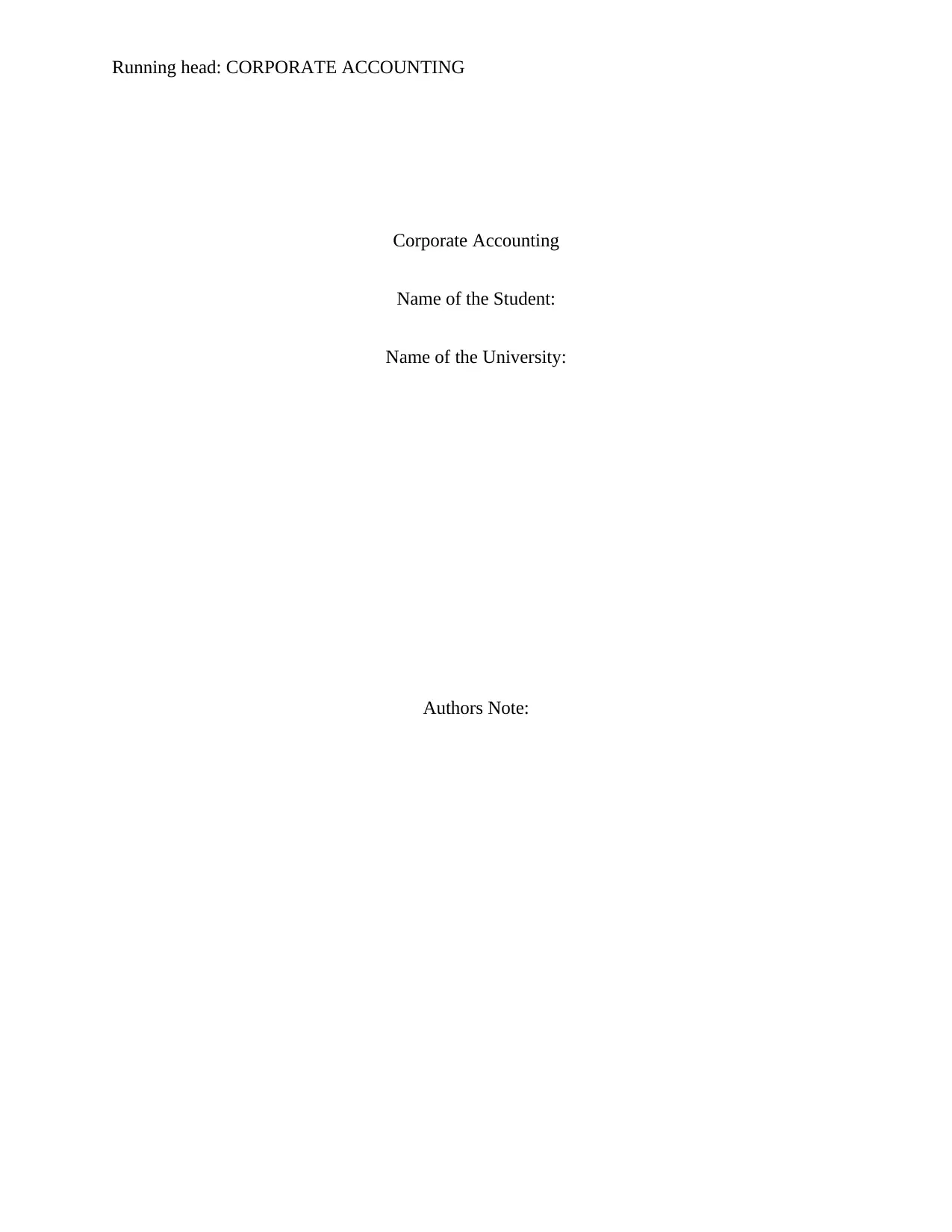
Running head: CORPORATE ACCOUNTING
Corporate Accounting
Name of the Student:
Name of the University:
Authors Note:
Corporate Accounting
Name of the Student:
Name of the University:
Authors Note:
Paraphrase This Document
Need a fresh take? Get an instant paraphrase of this document with our AI Paraphraser
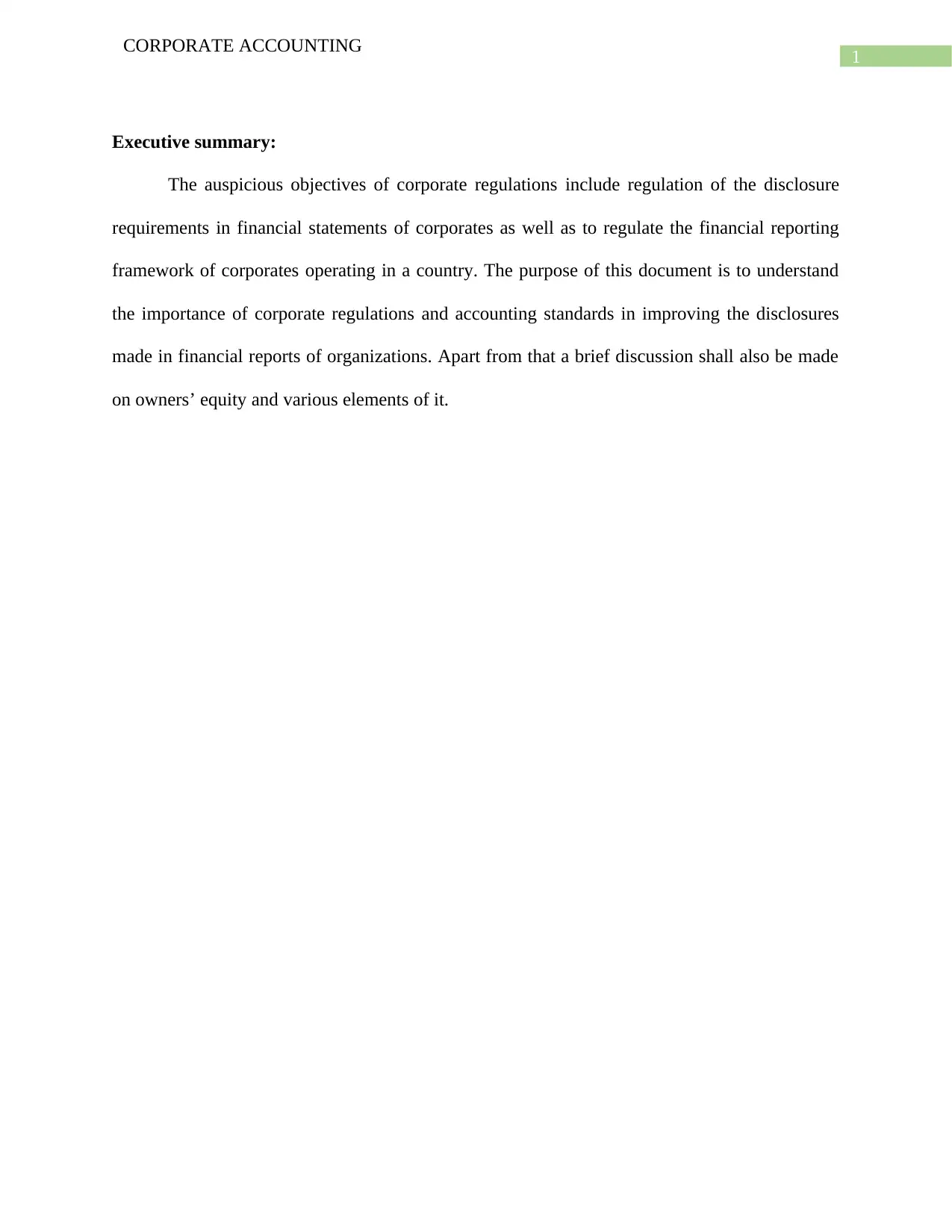
1
CORPORATE ACCOUNTING
Executive summary:
The auspicious objectives of corporate regulations include regulation of the disclosure
requirements in financial statements of corporates as well as to regulate the financial reporting
framework of corporates operating in a country. The purpose of this document is to understand
the importance of corporate regulations and accounting standards in improving the disclosures
made in financial reports of organizations. Apart from that a brief discussion shall also be made
on owners’ equity and various elements of it.
CORPORATE ACCOUNTING
Executive summary:
The auspicious objectives of corporate regulations include regulation of the disclosure
requirements in financial statements of corporates as well as to regulate the financial reporting
framework of corporates operating in a country. The purpose of this document is to understand
the importance of corporate regulations and accounting standards in improving the disclosures
made in financial reports of organizations. Apart from that a brief discussion shall also be made
on owners’ equity and various elements of it.
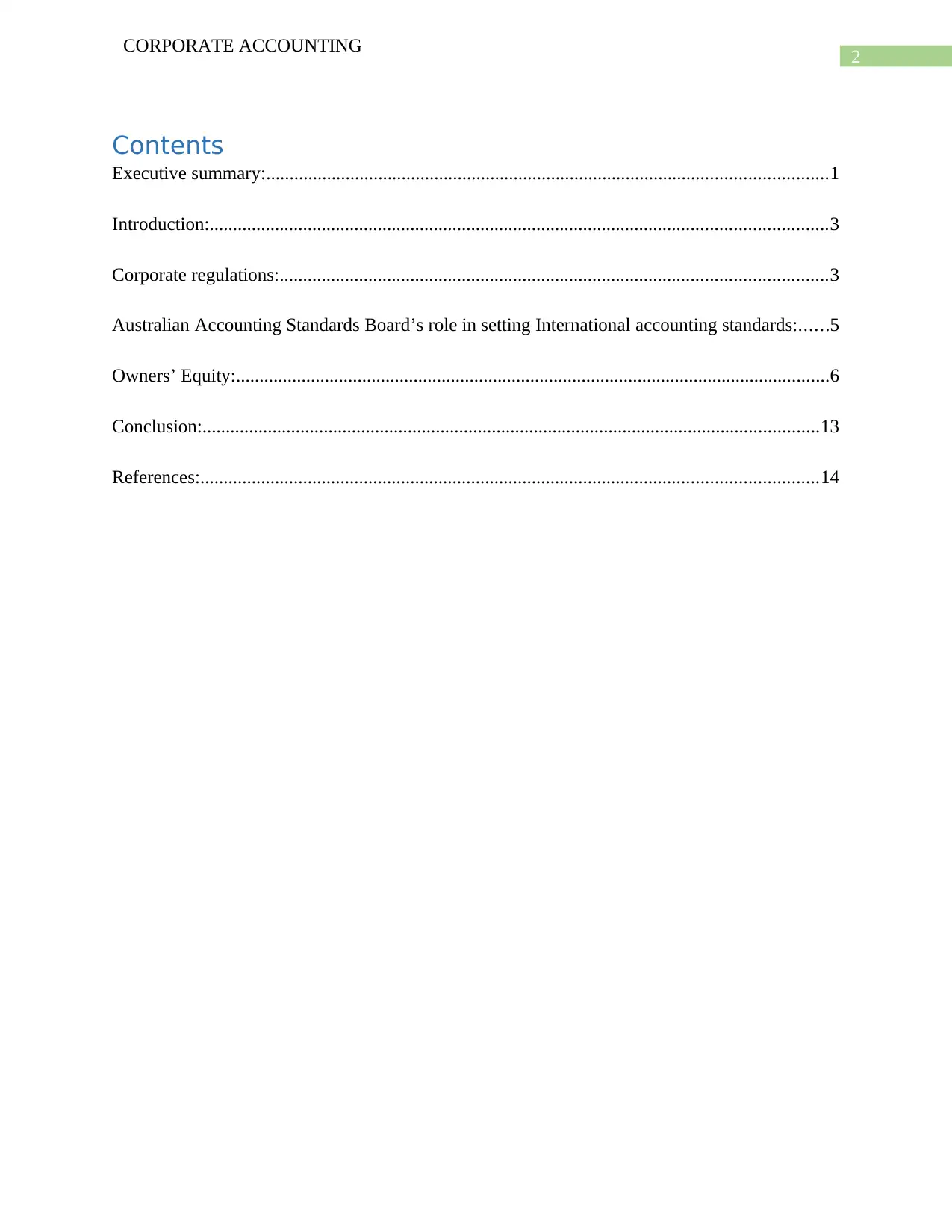
2
CORPORATE ACCOUNTING
Contents
Executive summary:........................................................................................................................1
Introduction:....................................................................................................................................3
Corporate regulations:.....................................................................................................................3
Australian Accounting Standards Board’s role in setting International accounting standards:......5
Owners’ Equity:...............................................................................................................................6
Conclusion:....................................................................................................................................13
References:....................................................................................................................................14
CORPORATE ACCOUNTING
Contents
Executive summary:........................................................................................................................1
Introduction:....................................................................................................................................3
Corporate regulations:.....................................................................................................................3
Australian Accounting Standards Board’s role in setting International accounting standards:......5
Owners’ Equity:...............................................................................................................................6
Conclusion:....................................................................................................................................13
References:....................................................................................................................................14
⊘ This is a preview!⊘
Do you want full access?
Subscribe today to unlock all pages.

Trusted by 1+ million students worldwide
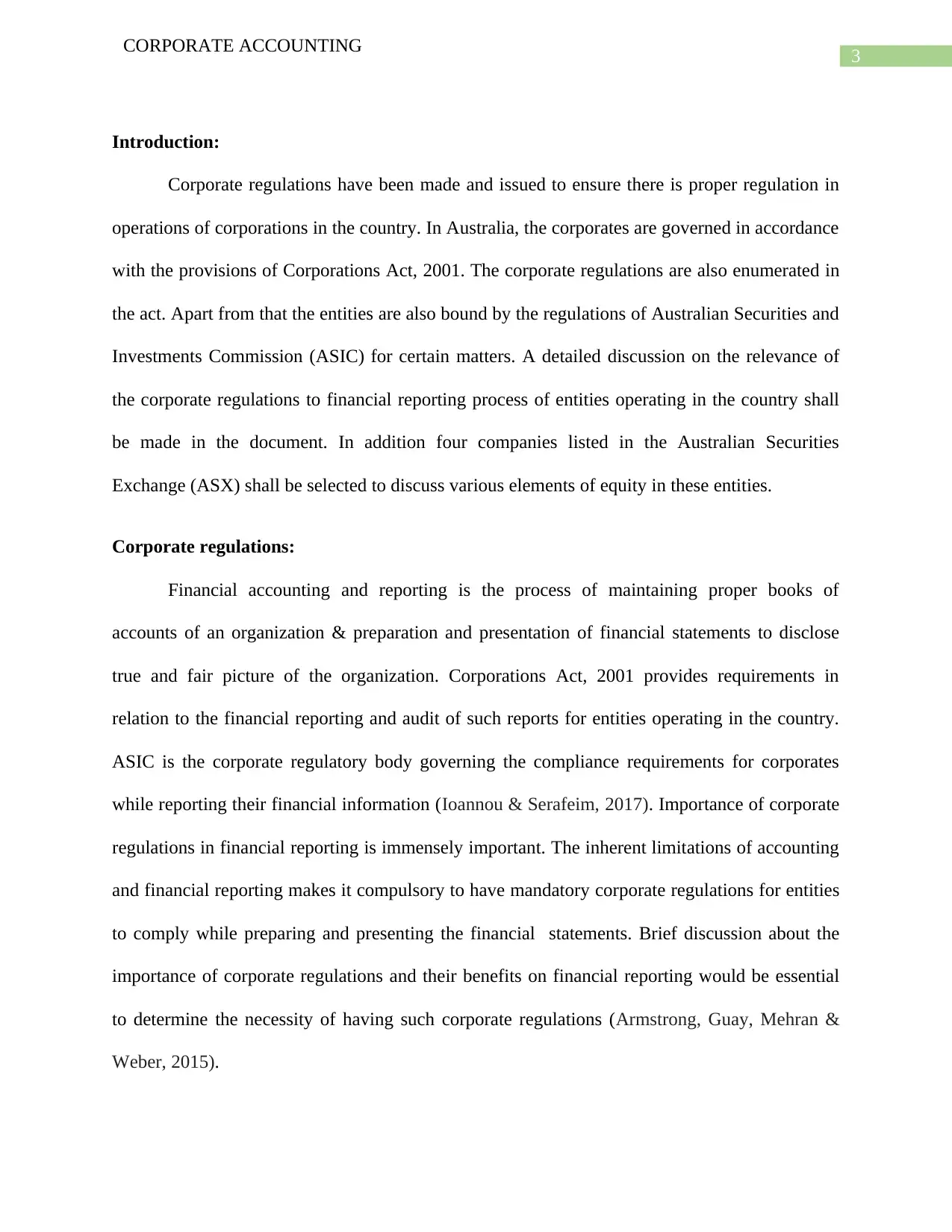
3
CORPORATE ACCOUNTING
Introduction:
Corporate regulations have been made and issued to ensure there is proper regulation in
operations of corporations in the country. In Australia, the corporates are governed in accordance
with the provisions of Corporations Act, 2001. The corporate regulations are also enumerated in
the act. Apart from that the entities are also bound by the regulations of Australian Securities and
Investments Commission (ASIC) for certain matters. A detailed discussion on the relevance of
the corporate regulations to financial reporting process of entities operating in the country shall
be made in the document. In addition four companies listed in the Australian Securities
Exchange (ASX) shall be selected to discuss various elements of equity in these entities.
Corporate regulations:
Financial accounting and reporting is the process of maintaining proper books of
accounts of an organization & preparation and presentation of financial statements to disclose
true and fair picture of the organization. Corporations Act, 2001 provides requirements in
relation to the financial reporting and audit of such reports for entities operating in the country.
ASIC is the corporate regulatory body governing the compliance requirements for corporates
while reporting their financial information (Ioannou & Serafeim, 2017). Importance of corporate
regulations in financial reporting is immensely important. The inherent limitations of accounting
and financial reporting makes it compulsory to have mandatory corporate regulations for entities
to comply while preparing and presenting the financial statements. Brief discussion about the
importance of corporate regulations and their benefits on financial reporting would be essential
to determine the necessity of having such corporate regulations (Armstrong, Guay, Mehran &
Weber, 2015).
CORPORATE ACCOUNTING
Introduction:
Corporate regulations have been made and issued to ensure there is proper regulation in
operations of corporations in the country. In Australia, the corporates are governed in accordance
with the provisions of Corporations Act, 2001. The corporate regulations are also enumerated in
the act. Apart from that the entities are also bound by the regulations of Australian Securities and
Investments Commission (ASIC) for certain matters. A detailed discussion on the relevance of
the corporate regulations to financial reporting process of entities operating in the country shall
be made in the document. In addition four companies listed in the Australian Securities
Exchange (ASX) shall be selected to discuss various elements of equity in these entities.
Corporate regulations:
Financial accounting and reporting is the process of maintaining proper books of
accounts of an organization & preparation and presentation of financial statements to disclose
true and fair picture of the organization. Corporations Act, 2001 provides requirements in
relation to the financial reporting and audit of such reports for entities operating in the country.
ASIC is the corporate regulatory body governing the compliance requirements for corporates
while reporting their financial information (Ioannou & Serafeim, 2017). Importance of corporate
regulations in financial reporting is immensely important. The inherent limitations of accounting
and financial reporting makes it compulsory to have mandatory corporate regulations for entities
to comply while preparing and presenting the financial statements. Brief discussion about the
importance of corporate regulations and their benefits on financial reporting would be essential
to determine the necessity of having such corporate regulations (Armstrong, Guay, Mehran &
Weber, 2015).
Paraphrase This Document
Need a fresh take? Get an instant paraphrase of this document with our AI Paraphraser
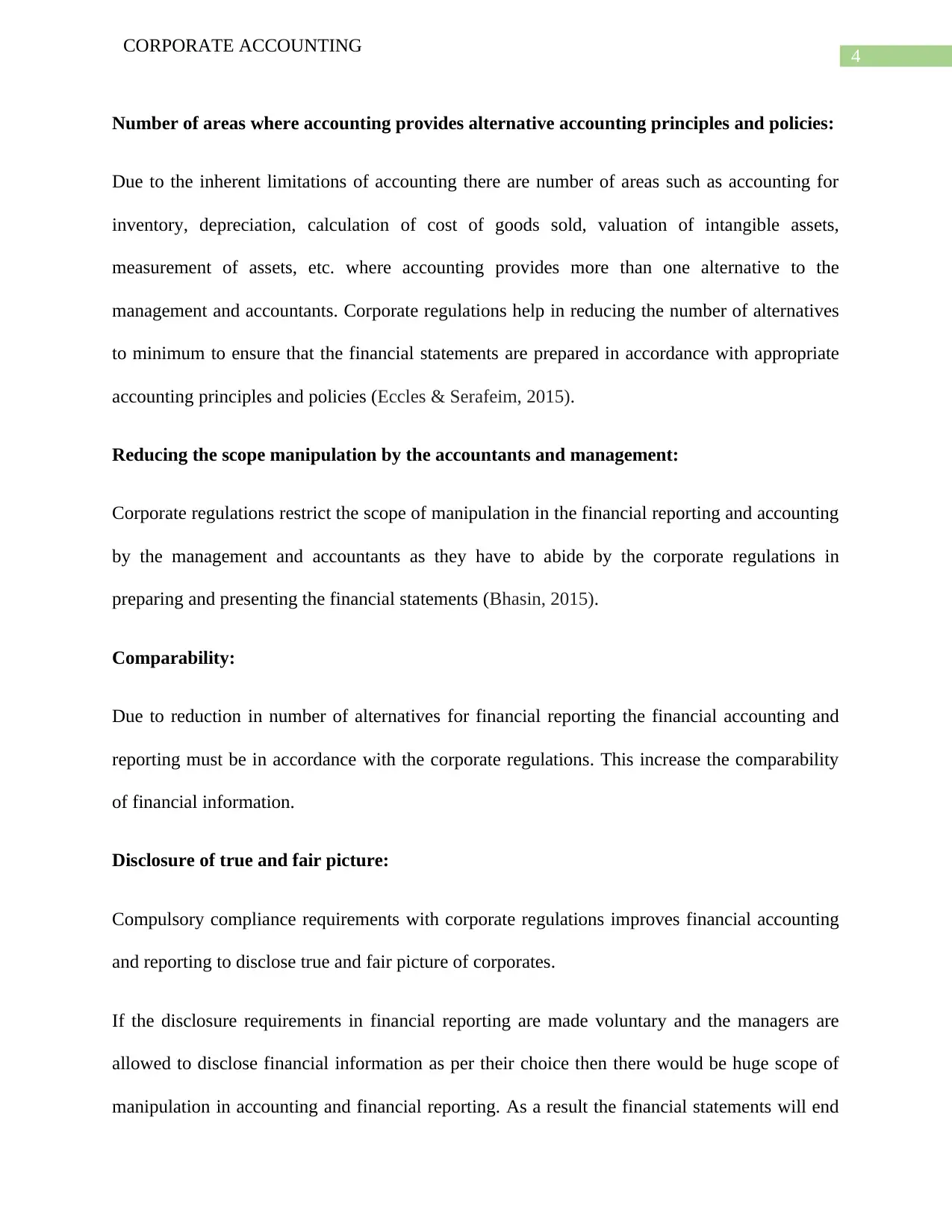
4
CORPORATE ACCOUNTING
Number of areas where accounting provides alternative accounting principles and policies:
Due to the inherent limitations of accounting there are number of areas such as accounting for
inventory, depreciation, calculation of cost of goods sold, valuation of intangible assets,
measurement of assets, etc. where accounting provides more than one alternative to the
management and accountants. Corporate regulations help in reducing the number of alternatives
to minimum to ensure that the financial statements are prepared in accordance with appropriate
accounting principles and policies (Eccles & Serafeim, 2015).
Reducing the scope manipulation by the accountants and management:
Corporate regulations restrict the scope of manipulation in the financial reporting and accounting
by the management and accountants as they have to abide by the corporate regulations in
preparing and presenting the financial statements (Bhasin, 2015).
Comparability:
Due to reduction in number of alternatives for financial reporting the financial accounting and
reporting must be in accordance with the corporate regulations. This increase the comparability
of financial information.
Disclosure of true and fair picture:
Compulsory compliance requirements with corporate regulations improves financial accounting
and reporting to disclose true and fair picture of corporates.
If the disclosure requirements in financial reporting are made voluntary and the managers are
allowed to disclose financial information as per their choice then there would be huge scope of
manipulation in accounting and financial reporting. As a result the financial statements will end
CORPORATE ACCOUNTING
Number of areas where accounting provides alternative accounting principles and policies:
Due to the inherent limitations of accounting there are number of areas such as accounting for
inventory, depreciation, calculation of cost of goods sold, valuation of intangible assets,
measurement of assets, etc. where accounting provides more than one alternative to the
management and accountants. Corporate regulations help in reducing the number of alternatives
to minimum to ensure that the financial statements are prepared in accordance with appropriate
accounting principles and policies (Eccles & Serafeim, 2015).
Reducing the scope manipulation by the accountants and management:
Corporate regulations restrict the scope of manipulation in the financial reporting and accounting
by the management and accountants as they have to abide by the corporate regulations in
preparing and presenting the financial statements (Bhasin, 2015).
Comparability:
Due to reduction in number of alternatives for financial reporting the financial accounting and
reporting must be in accordance with the corporate regulations. This increase the comparability
of financial information.
Disclosure of true and fair picture:
Compulsory compliance requirements with corporate regulations improves financial accounting
and reporting to disclose true and fair picture of corporates.
If the disclosure requirements in financial reporting are made voluntary and the managers are
allowed to disclose financial information as per their choice then there would be huge scope of
manipulation in accounting and financial reporting. As a result the financial statements will end
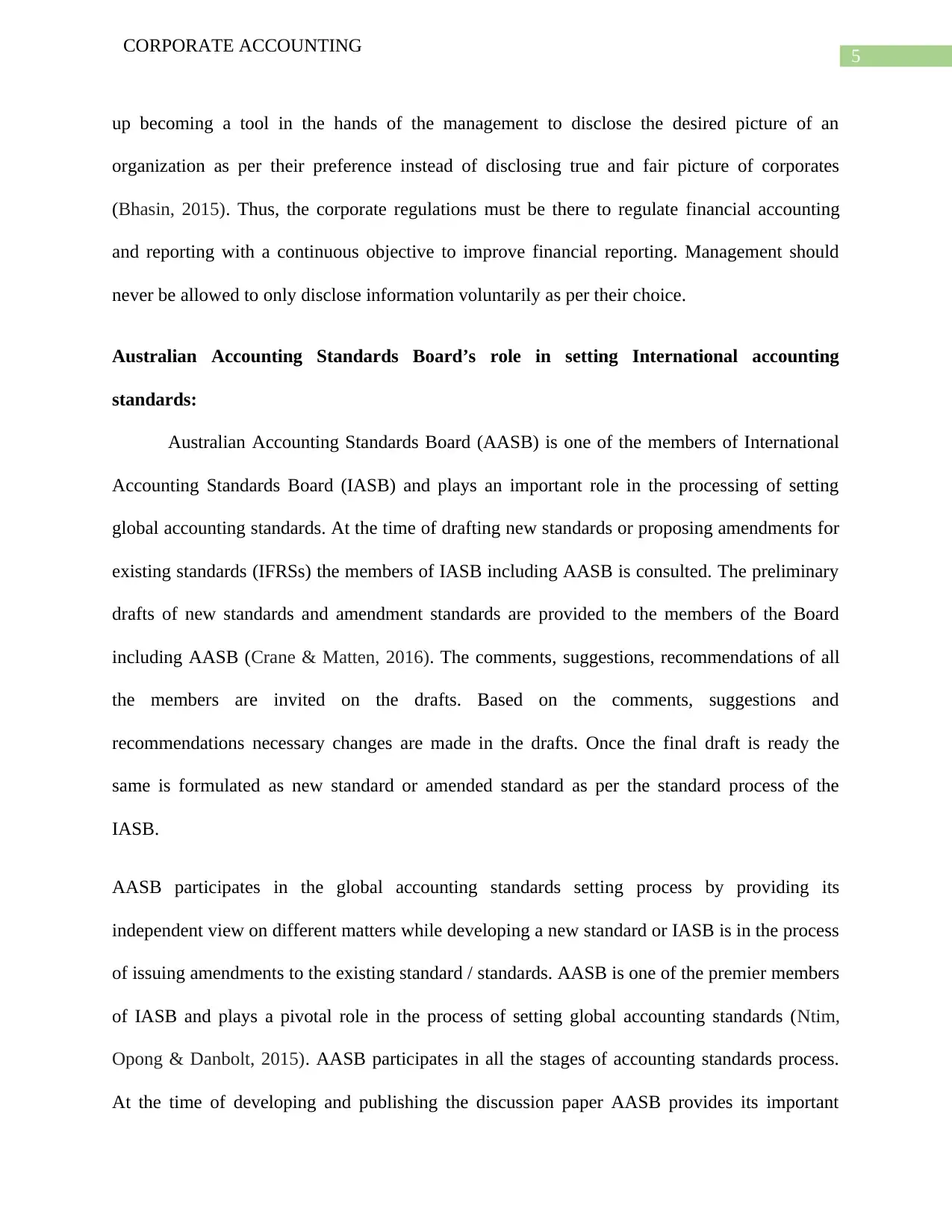
5
CORPORATE ACCOUNTING
up becoming a tool in the hands of the management to disclose the desired picture of an
organization as per their preference instead of disclosing true and fair picture of corporates
(Bhasin, 2015). Thus, the corporate regulations must be there to regulate financial accounting
and reporting with a continuous objective to improve financial reporting. Management should
never be allowed to only disclose information voluntarily as per their choice.
Australian Accounting Standards Board’s role in setting International accounting
standards:
Australian Accounting Standards Board (AASB) is one of the members of International
Accounting Standards Board (IASB) and plays an important role in the processing of setting
global accounting standards. At the time of drafting new standards or proposing amendments for
existing standards (IFRSs) the members of IASB including AASB is consulted. The preliminary
drafts of new standards and amendment standards are provided to the members of the Board
including AASB (Crane & Matten, 2016). The comments, suggestions, recommendations of all
the members are invited on the drafts. Based on the comments, suggestions and
recommendations necessary changes are made in the drafts. Once the final draft is ready the
same is formulated as new standard or amended standard as per the standard process of the
IASB.
AASB participates in the global accounting standards setting process by providing its
independent view on different matters while developing a new standard or IASB is in the process
of issuing amendments to the existing standard / standards. AASB is one of the premier members
of IASB and plays a pivotal role in the process of setting global accounting standards (Ntim,
Opong & Danbolt, 2015). AASB participates in all the stages of accounting standards process.
At the time of developing and publishing the discussion paper AASB provides its important
CORPORATE ACCOUNTING
up becoming a tool in the hands of the management to disclose the desired picture of an
organization as per their preference instead of disclosing true and fair picture of corporates
(Bhasin, 2015). Thus, the corporate regulations must be there to regulate financial accounting
and reporting with a continuous objective to improve financial reporting. Management should
never be allowed to only disclose information voluntarily as per their choice.
Australian Accounting Standards Board’s role in setting International accounting
standards:
Australian Accounting Standards Board (AASB) is one of the members of International
Accounting Standards Board (IASB) and plays an important role in the processing of setting
global accounting standards. At the time of drafting new standards or proposing amendments for
existing standards (IFRSs) the members of IASB including AASB is consulted. The preliminary
drafts of new standards and amendment standards are provided to the members of the Board
including AASB (Crane & Matten, 2016). The comments, suggestions, recommendations of all
the members are invited on the drafts. Based on the comments, suggestions and
recommendations necessary changes are made in the drafts. Once the final draft is ready the
same is formulated as new standard or amended standard as per the standard process of the
IASB.
AASB participates in the global accounting standards setting process by providing its
independent view on different matters while developing a new standard or IASB is in the process
of issuing amendments to the existing standard / standards. AASB is one of the premier members
of IASB and plays a pivotal role in the process of setting global accounting standards (Ntim,
Opong & Danbolt, 2015). AASB participates in all the stages of accounting standards process.
At the time of developing and publishing the discussion paper AASB provides its important
⊘ This is a preview!⊘
Do you want full access?
Subscribe today to unlock all pages.

Trusted by 1+ million students worldwide
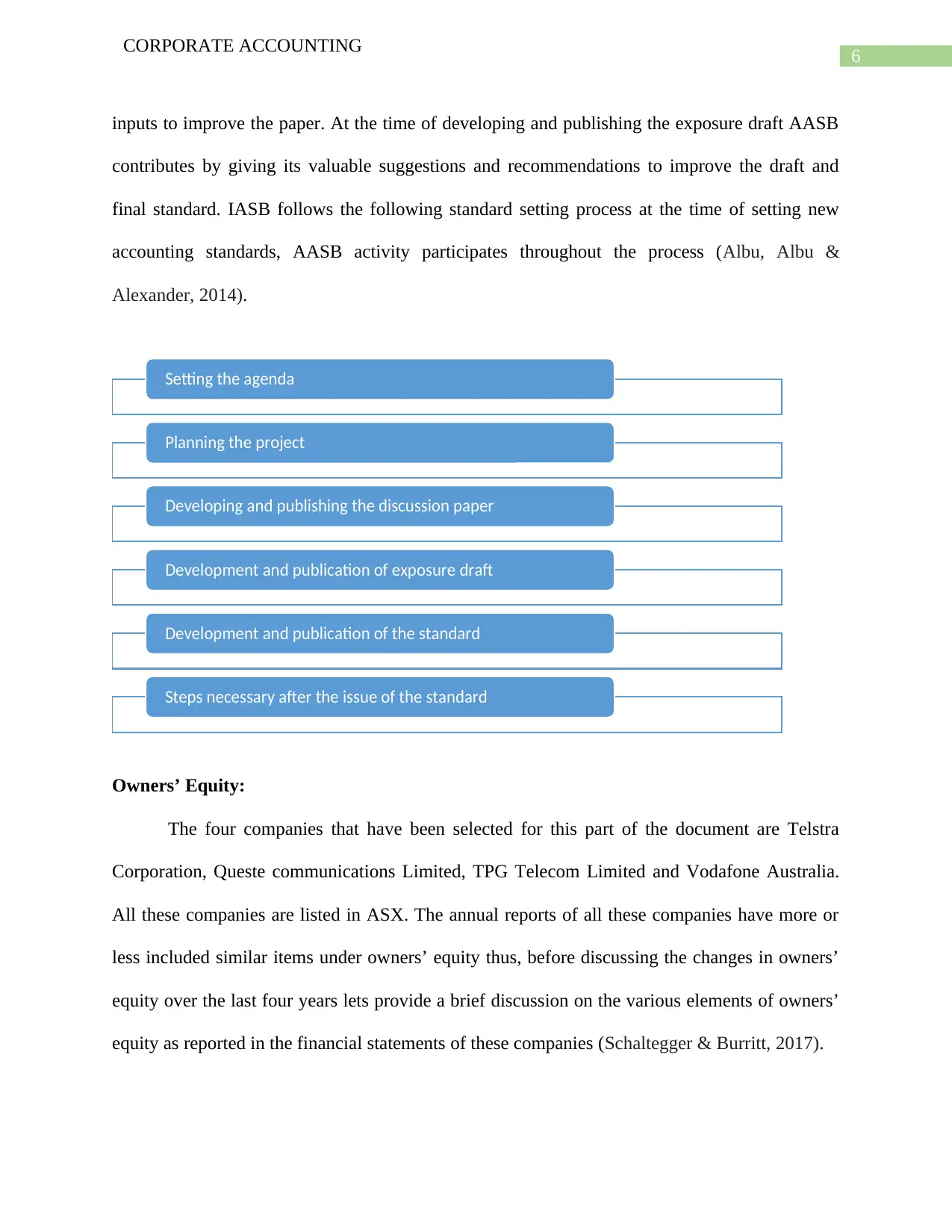
6
CORPORATE ACCOUNTING
inputs to improve the paper. At the time of developing and publishing the exposure draft AASB
contributes by giving its valuable suggestions and recommendations to improve the draft and
final standard. IASB follows the following standard setting process at the time of setting new
accounting standards, AASB activity participates throughout the process (Albu, Albu &
Alexander, 2014).
Owners’ Equity:
The four companies that have been selected for this part of the document are Telstra
Corporation, Queste communications Limited, TPG Telecom Limited and Vodafone Australia.
All these companies are listed in ASX. The annual reports of all these companies have more or
less included similar items under owners’ equity thus, before discussing the changes in owners’
equity over the last four years lets provide a brief discussion on the various elements of owners’
equity as reported in the financial statements of these companies (Schaltegger & Burritt, 2017).
Setting the agenda
Planning the project
Developing and publishing the discussion paper
Development and publication of exposure draft
Development and publication of the standard
Steps necessary after the issue of the standard
CORPORATE ACCOUNTING
inputs to improve the paper. At the time of developing and publishing the exposure draft AASB
contributes by giving its valuable suggestions and recommendations to improve the draft and
final standard. IASB follows the following standard setting process at the time of setting new
accounting standards, AASB activity participates throughout the process (Albu, Albu &
Alexander, 2014).
Owners’ Equity:
The four companies that have been selected for this part of the document are Telstra
Corporation, Queste communications Limited, TPG Telecom Limited and Vodafone Australia.
All these companies are listed in ASX. The annual reports of all these companies have more or
less included similar items under owners’ equity thus, before discussing the changes in owners’
equity over the last four years lets provide a brief discussion on the various elements of owners’
equity as reported in the financial statements of these companies (Schaltegger & Burritt, 2017).
Setting the agenda
Planning the project
Developing and publishing the discussion paper
Development and publication of exposure draft
Development and publication of the standard
Steps necessary after the issue of the standard
Paraphrase This Document
Need a fresh take? Get an instant paraphrase of this document with our AI Paraphraser
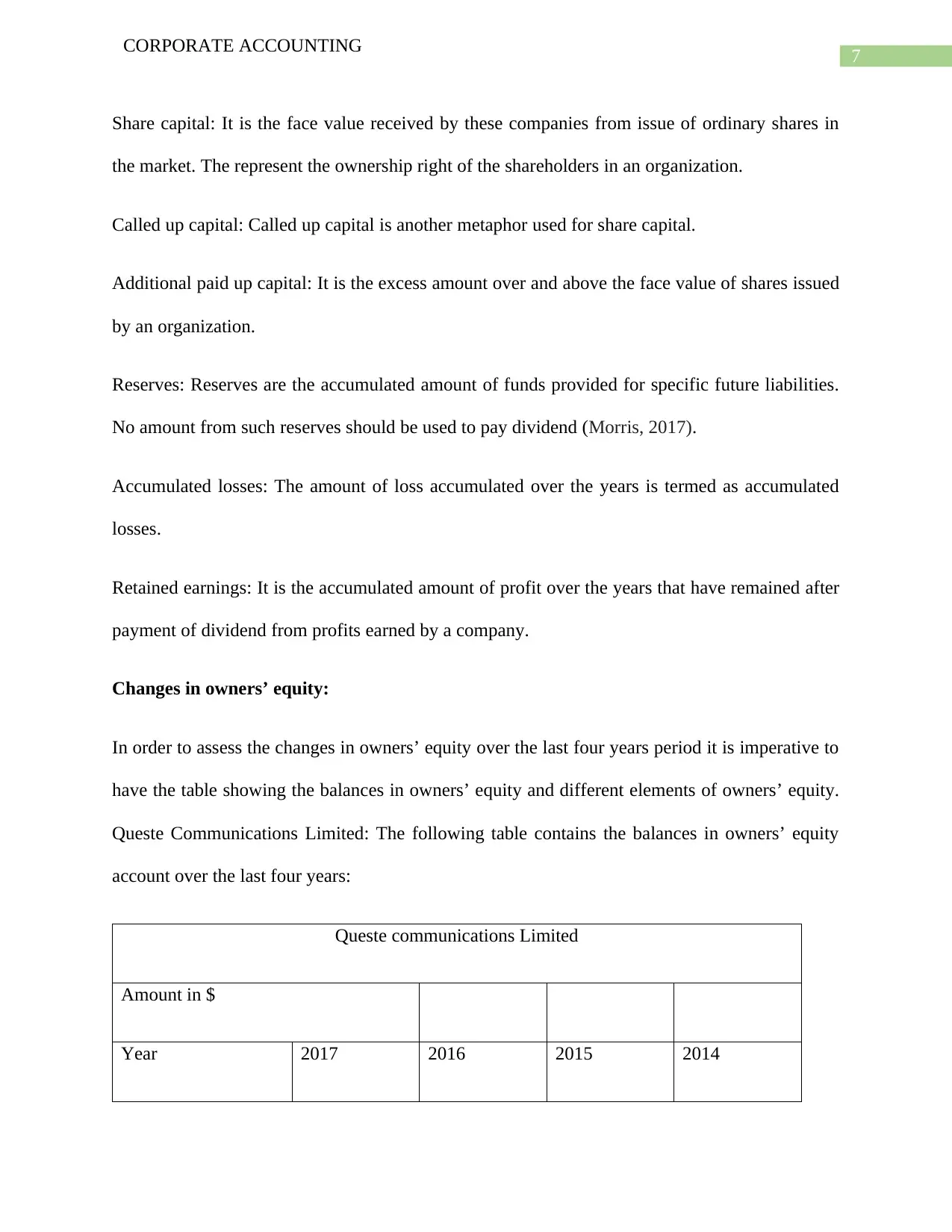
7
CORPORATE ACCOUNTING
Share capital: It is the face value received by these companies from issue of ordinary shares in
the market. The represent the ownership right of the shareholders in an organization.
Called up capital: Called up capital is another metaphor used for share capital.
Additional paid up capital: It is the excess amount over and above the face value of shares issued
by an organization.
Reserves: Reserves are the accumulated amount of funds provided for specific future liabilities.
No amount from such reserves should be used to pay dividend (Morris, 2017).
Accumulated losses: The amount of loss accumulated over the years is termed as accumulated
losses.
Retained earnings: It is the accumulated amount of profit over the years that have remained after
payment of dividend from profits earned by a company.
Changes in owners’ equity:
In order to assess the changes in owners’ equity over the last four years period it is imperative to
have the table showing the balances in owners’ equity and different elements of owners’ equity.
Queste Communications Limited: The following table contains the balances in owners’ equity
account over the last four years:
Queste communications Limited
Amount in $
Year 2017 2016 2015 2014
CORPORATE ACCOUNTING
Share capital: It is the face value received by these companies from issue of ordinary shares in
the market. The represent the ownership right of the shareholders in an organization.
Called up capital: Called up capital is another metaphor used for share capital.
Additional paid up capital: It is the excess amount over and above the face value of shares issued
by an organization.
Reserves: Reserves are the accumulated amount of funds provided for specific future liabilities.
No amount from such reserves should be used to pay dividend (Morris, 2017).
Accumulated losses: The amount of loss accumulated over the years is termed as accumulated
losses.
Retained earnings: It is the accumulated amount of profit over the years that have remained after
payment of dividend from profits earned by a company.
Changes in owners’ equity:
In order to assess the changes in owners’ equity over the last four years period it is imperative to
have the table showing the balances in owners’ equity and different elements of owners’ equity.
Queste Communications Limited: The following table contains the balances in owners’ equity
account over the last four years:
Queste communications Limited
Amount in $
Year 2017 2016 2015 2014
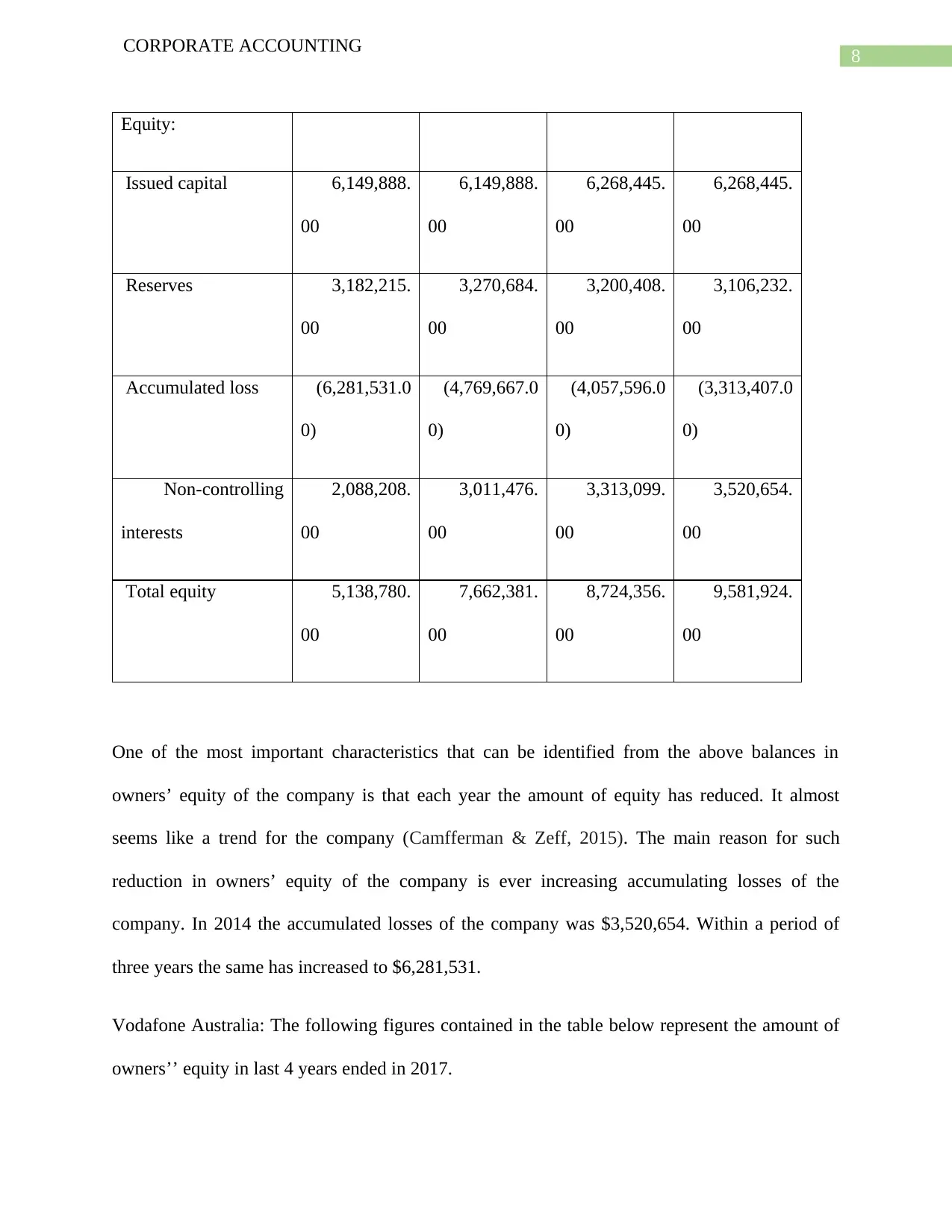
8
CORPORATE ACCOUNTING
Equity:
Issued capital 6,149,888.
00
6,149,888.
00
6,268,445.
00
6,268,445.
00
Reserves 3,182,215.
00
3,270,684.
00
3,200,408.
00
3,106,232.
00
Accumulated loss (6,281,531.0
0)
(4,769,667.0
0)
(4,057,596.0
0)
(3,313,407.0
0)
Non-controlling
interests
2,088,208.
00
3,011,476.
00
3,313,099.
00
3,520,654.
00
Total equity 5,138,780.
00
7,662,381.
00
8,724,356.
00
9,581,924.
00
One of the most important characteristics that can be identified from the above balances in
owners’ equity of the company is that each year the amount of equity has reduced. It almost
seems like a trend for the company (Camfferman & Zeff, 2015). The main reason for such
reduction in owners’ equity of the company is ever increasing accumulating losses of the
company. In 2014 the accumulated losses of the company was $3,520,654. Within a period of
three years the same has increased to $6,281,531.
Vodafone Australia: The following figures contained in the table below represent the amount of
owners’’ equity in last 4 years ended in 2017.
CORPORATE ACCOUNTING
Equity:
Issued capital 6,149,888.
00
6,149,888.
00
6,268,445.
00
6,268,445.
00
Reserves 3,182,215.
00
3,270,684.
00
3,200,408.
00
3,106,232.
00
Accumulated loss (6,281,531.0
0)
(4,769,667.0
0)
(4,057,596.0
0)
(3,313,407.0
0)
Non-controlling
interests
2,088,208.
00
3,011,476.
00
3,313,099.
00
3,520,654.
00
Total equity 5,138,780.
00
7,662,381.
00
8,724,356.
00
9,581,924.
00
One of the most important characteristics that can be identified from the above balances in
owners’ equity of the company is that each year the amount of equity has reduced. It almost
seems like a trend for the company (Camfferman & Zeff, 2015). The main reason for such
reduction in owners’ equity of the company is ever increasing accumulating losses of the
company. In 2014 the accumulated losses of the company was $3,520,654. Within a period of
three years the same has increased to $6,281,531.
Vodafone Australia: The following figures contained in the table below represent the amount of
owners’’ equity in last 4 years ended in 2017.
⊘ This is a preview!⊘
Do you want full access?
Subscribe today to unlock all pages.

Trusted by 1+ million students worldwide
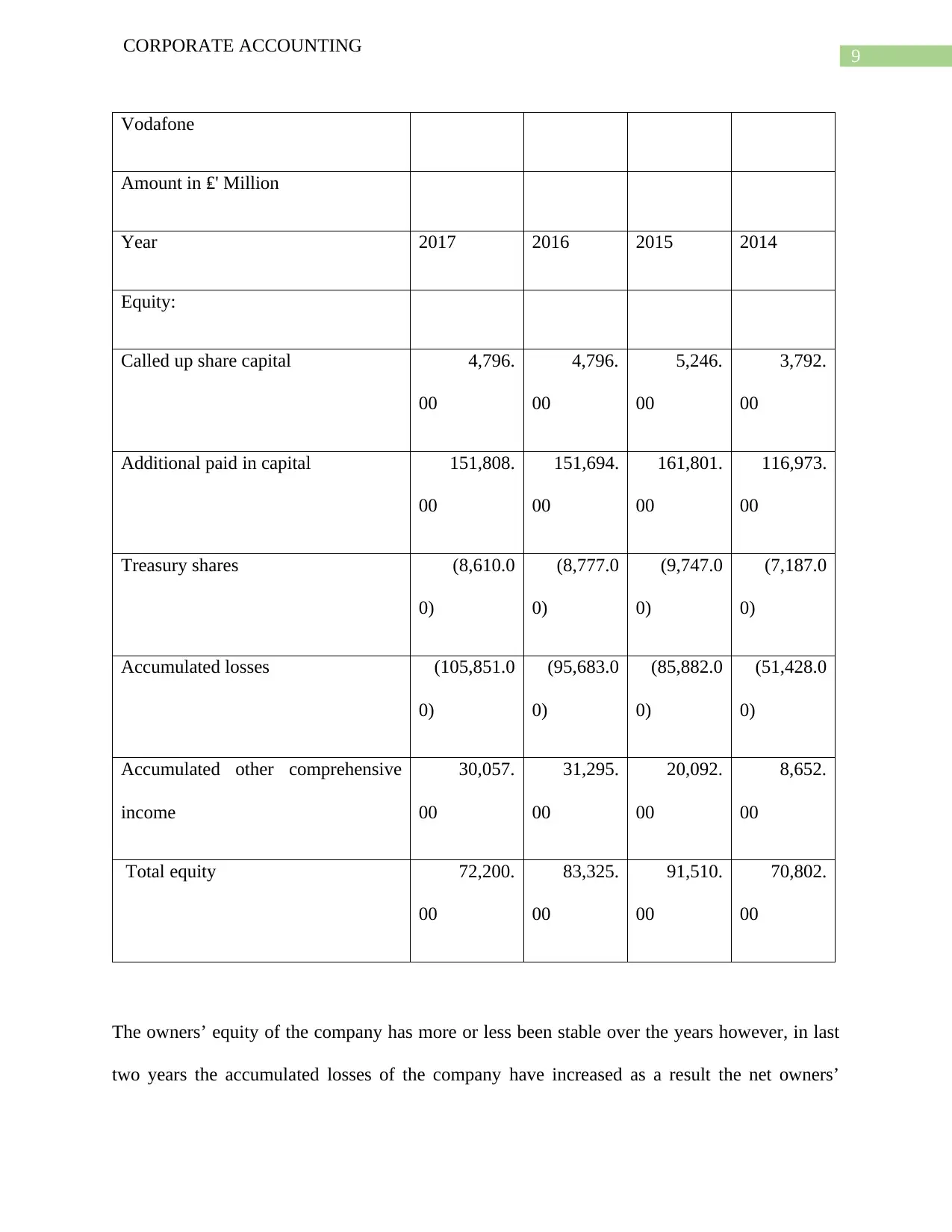
9
CORPORATE ACCOUNTING
Vodafone
Amount in ₤' Million
Year 2017 2016 2015 2014
Equity:
Called up share capital 4,796.
00
4,796.
00
5,246.
00
3,792.
00
Additional paid in capital 151,808.
00
151,694.
00
161,801.
00
116,973.
00
Treasury shares (8,610.0
0)
(8,777.0
0)
(9,747.0
0)
(7,187.0
0)
Accumulated losses (105,851.0
0)
(95,683.0
0)
(85,882.0
0)
(51,428.0
0)
Accumulated other comprehensive
income
30,057.
00
31,295.
00
20,092.
00
8,652.
00
Total equity 72,200.
00
83,325.
00
91,510.
00
70,802.
00
The owners’ equity of the company has more or less been stable over the years however, in last
two years the accumulated losses of the company have increased as a result the net owners’
CORPORATE ACCOUNTING
Vodafone
Amount in ₤' Million
Year 2017 2016 2015 2014
Equity:
Called up share capital 4,796.
00
4,796.
00
5,246.
00
3,792.
00
Additional paid in capital 151,808.
00
151,694.
00
161,801.
00
116,973.
00
Treasury shares (8,610.0
0)
(8,777.0
0)
(9,747.0
0)
(7,187.0
0)
Accumulated losses (105,851.0
0)
(95,683.0
0)
(85,882.0
0)
(51,428.0
0)
Accumulated other comprehensive
income
30,057.
00
31,295.
00
20,092.
00
8,652.
00
Total equity 72,200.
00
83,325.
00
91,510.
00
70,802.
00
The owners’ equity of the company has more or less been stable over the years however, in last
two years the accumulated losses of the company have increased as a result the net owners’
Paraphrase This Document
Need a fresh take? Get an instant paraphrase of this document with our AI Paraphraser
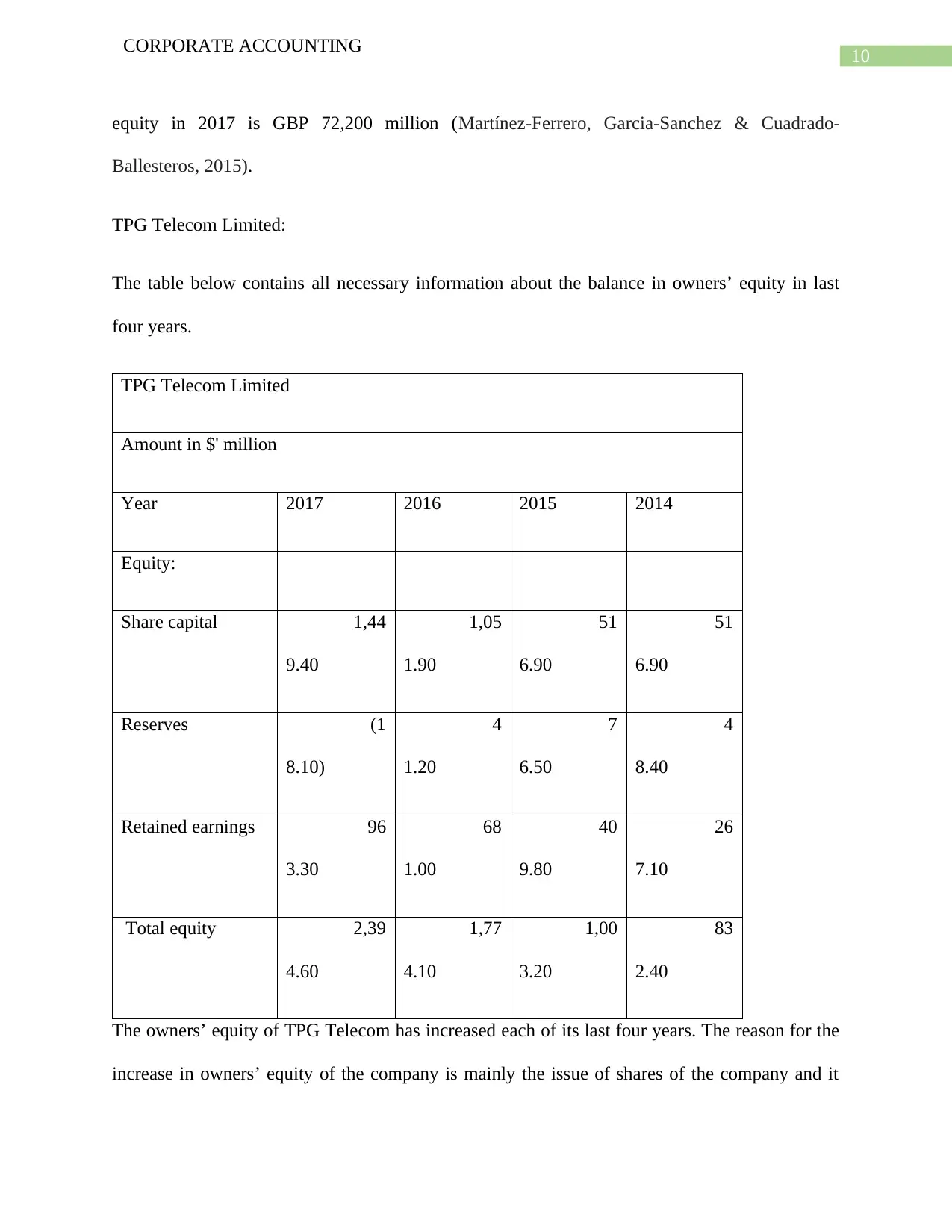
10
CORPORATE ACCOUNTING
equity in 2017 is GBP 72,200 million (Martínez‐Ferrero, Garcia‐Sanchez & Cuadrado‐
Ballesteros, 2015).
TPG Telecom Limited:
The table below contains all necessary information about the balance in owners’ equity in last
four years.
TPG Telecom Limited
Amount in $' million
Year 2017 2016 2015 2014
Equity:
Share capital 1,44
9.40
1,05
1.90
51
6.90
51
6.90
Reserves (1
8.10)
4
1.20
7
6.50
4
8.40
Retained earnings 96
3.30
68
1.00
40
9.80
26
7.10
Total equity 2,39
4.60
1,77
4.10
1,00
3.20
83
2.40
The owners’ equity of TPG Telecom has increased each of its last four years. The reason for the
increase in owners’ equity of the company is mainly the issue of shares of the company and it
CORPORATE ACCOUNTING
equity in 2017 is GBP 72,200 million (Martínez‐Ferrero, Garcia‐Sanchez & Cuadrado‐
Ballesteros, 2015).
TPG Telecom Limited:
The table below contains all necessary information about the balance in owners’ equity in last
four years.
TPG Telecom Limited
Amount in $' million
Year 2017 2016 2015 2014
Equity:
Share capital 1,44
9.40
1,05
1.90
51
6.90
51
6.90
Reserves (1
8.10)
4
1.20
7
6.50
4
8.40
Retained earnings 96
3.30
68
1.00
40
9.80
26
7.10
Total equity 2,39
4.60
1,77
4.10
1,00
3.20
83
2.40
The owners’ equity of TPG Telecom has increased each of its last four years. The reason for the
increase in owners’ equity of the company is mainly the issue of shares of the company and it
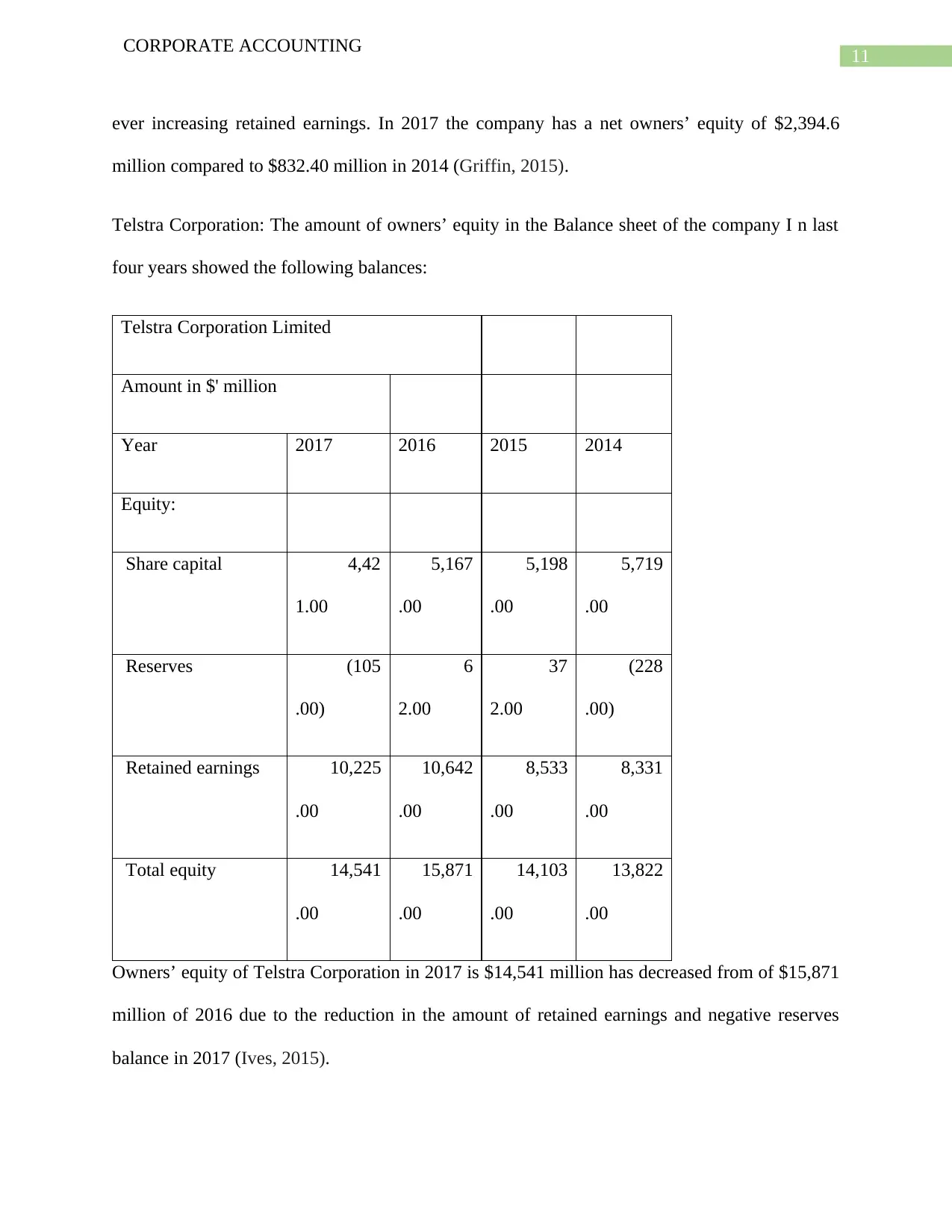
11
CORPORATE ACCOUNTING
ever increasing retained earnings. In 2017 the company has a net owners’ equity of $2,394.6
million compared to $832.40 million in 2014 (Griffin, 2015).
Telstra Corporation: The amount of owners’ equity in the Balance sheet of the company I n last
four years showed the following balances:
Telstra Corporation Limited
Amount in $' million
Year 2017 2016 2015 2014
Equity:
Share capital 4,42
1.00
5,167
.00
5,198
.00
5,719
.00
Reserves (105
.00)
6
2.00
37
2.00
(228
.00)
Retained earnings 10,225
.00
10,642
.00
8,533
.00
8,331
.00
Total equity 14,541
.00
15,871
.00
14,103
.00
13,822
.00
Owners’ equity of Telstra Corporation in 2017 is $14,541 million has decreased from of $15,871
million of 2016 due to the reduction in the amount of retained earnings and negative reserves
balance in 2017 (Ives, 2015).
CORPORATE ACCOUNTING
ever increasing retained earnings. In 2017 the company has a net owners’ equity of $2,394.6
million compared to $832.40 million in 2014 (Griffin, 2015).
Telstra Corporation: The amount of owners’ equity in the Balance sheet of the company I n last
four years showed the following balances:
Telstra Corporation Limited
Amount in $' million
Year 2017 2016 2015 2014
Equity:
Share capital 4,42
1.00
5,167
.00
5,198
.00
5,719
.00
Reserves (105
.00)
6
2.00
37
2.00
(228
.00)
Retained earnings 10,225
.00
10,642
.00
8,533
.00
8,331
.00
Total equity 14,541
.00
15,871
.00
14,103
.00
13,822
.00
Owners’ equity of Telstra Corporation in 2017 is $14,541 million has decreased from of $15,871
million of 2016 due to the reduction in the amount of retained earnings and negative reserves
balance in 2017 (Ives, 2015).
⊘ This is a preview!⊘
Do you want full access?
Subscribe today to unlock all pages.

Trusted by 1+ million students worldwide
1 out of 17
Related Documents
Your All-in-One AI-Powered Toolkit for Academic Success.
+13062052269
info@desklib.com
Available 24*7 on WhatsApp / Email
![[object Object]](/_next/static/media/star-bottom.7253800d.svg)
Unlock your academic potential
Copyright © 2020–2025 A2Z Services. All Rights Reserved. Developed and managed by ZUCOL.



